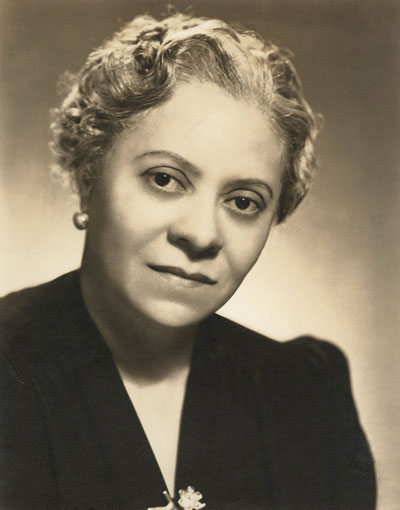Florence Price

Born: April 9, 1888, Little Rock, Arkansas
Died: June 3, 1953, Chicago, Illinois
Concerto No. 2 for Violin and Orchestra
- Composed: 1952
- Premiere: 1953, in recital in Chicago, by its dedicatee Minnie Cedargreen Jernberg, violin
- CSO Notable Performances: These are the CSO’s first performances of this work.
- Instrumentation: solo violin, 2 flutes, 2 oboes, English horn, 2 clarinets, 2 bassoons, 4 horns, 2 trumpets, 3 trombones, tuba, timpani, bass drum, cymbals, snare drum, triangle harp, celeste and strings
- Duration: approx. 16 minutes
Of the two violin concertos composed by Florence Price, it is her Violin Concerto No. 2 that we know the most about. We know it was co-commissioned by the Illinois Federation of Music Clubs, the Chicago Club of Women Musicians, the Lake View Musical Society and Mu Phi Epsilon. We know it was completed in 1952 and performed several times by its dedicatee, Minnie Cedargreen Jernberg: first in 1953, then in 1955 as part of a Musicians Club of Women recital in Chicago’s Fine Arts Building, room 833. The third time was in 1964, as part of the ceremony to dedicate Florence B. Price Elementary, an addition to the Chicago Public School system that shuttered in 2011.
But from 1964 until 2009, the Violin Concerto No. 2 and its older counterpart languished. The scores and parts were MIA; scholars considered both works to be lost. Then Vicki and Darrell Gatwood purchased Price’s former summer home in 2009, recognized the importance of the water-damaged materials in the damaged house and contacted archivists at the University of Arkansas-Fayetteville. From that collection, the archivists recovered Price’s violin concertos. And nine years later,Fayetteville university professor Er-Gene Kahng released the debut recording of Price’s violin concertos with the Janáček Philharmonic, thrusting the works back into the public sphere. Melissa White, Randall Goosby, Rachel Barton Pine and others have since incorporated these works into their repertoire, providing more opportunities to hear a range of interpretations, the beginning of a performance practice.
The contributions of Black and women composers to the concerto repertoire in the 20th century is much more extensive than is publicly known. Notable examples include Samuel Coleridge-Taylor’s G Minor Concerto, written for famed American virtuosa Maud Powell, Dame Ethel Smyth’s concerto for violin and horn, Ruth Gipps’ double concerto for violin and viola, Grażyna Bacewicz’s seven violin concertos, Julia Perry’s violin concerto and David Baker’s concerto for violin and jazz band. Price’s Violin Concerto No. 2, specifically, not only enhances our understanding of her style but also shows how composers continued to approach the concerto genre with creativity and originality.
First, Price’s Concerto No. 2 is not in the typical three or four movements, or sections. While Price is not the first composer to do this, the form she uses–double variation–indicates her integration of Black music practices. The work is divided into two large sections with two subsections and a coda, each subsection connected by an interlude. The concerto features three main themes: a martial theme, a primary theme and a secondary theme, each of which reappears in the four subsections and coda. Price re-introduces the themes in different keys, instrumentations and textures, procedures common in styles like Negro spirituals, jazz, gospel and blues. The martial theme, introduced by the orchestra, serves as the signal of the start of a new section. In the opening statement, the orchestra is unified and cohesive, oscillating between D major and D minor key areas. The resulting tension is lessened with the entrance of the soloist in a cadenza-like section that leads to the first statement of the primary theme, pastoral and lilting. The rhythmic opening of this primary theme becomes a core structural feature throughout the rest of the work, passed around the orchestra in call-and-response textures and in different keys. After a sweeping rhapsodic development, the secondary theme is introduced in D-flat major, a soaring, aching melody. Near the end of the piece, when this theme returns in B-flat major, Price gives the melody to the flutes and oboes, allowing the soloist to show off a subdued virtuosity with running sextuplets, leading to another interlude that flows to the last full section before the coda.
As noted by Katharina Uhde and R. Larry Todd, Price’s violin writing in this concerto highlights her subtle approach to virtuosity. The technique, while challenging, is always idiomatic; each passage takes full advantage of the violin’s resonance, long phrasing and higher range. The Violin Concerto No. 2 is also an example of the conversational structure that Price used in many of her instrumental works. Even when the soloist is the focus, the orchestra is busy passing sections, fragments and counter-melodies of the primary theme back and forth. It’s a clever balance of textural standards from Western classical and Black American practices, a core feature of Price’s style.
Although created by a historical figure, the Violin Concerto No. 2 is a new work—new to audiences, orchestras, soloists and scholars—providing not only an opportunity to hear a work thought lost and by an underappreciated composer but also to consciously and consistently expand one’s musical knowledge, listening techniques and engagement with a piece of music. Further, as Price’s music appears more frequently on orchestral programs, audiences have a chance to become part of the development of ideas, opinions and discussions of how to hear and understand Florence Price.
—Dr. A. Kori Hill